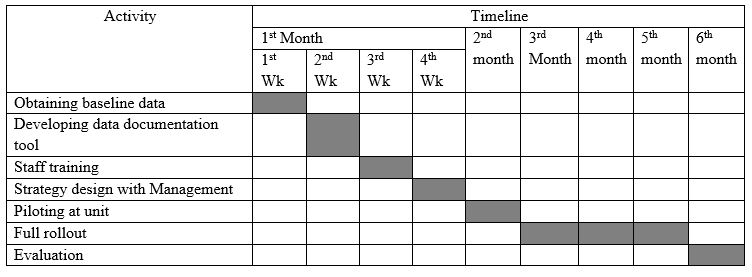Introduction
In nursing contexts, successful implementation of evidence-based practice (EBP) improves patients care outcomes by assisting to close the gap between research and clinical nursing practice (Beyea & Slattery, 2006). This paper describes the methods to be used in implementing bundled practices to minimize the prevalence of ventilator-associated pneumonia.
Setting and Subjects
The solution will be implemented in the intensive care unit, which caters to critically ill patients and those requiring specialized attention due to the nature of their illness. A meeting will be held to inform nurses working in the unit about the solution and also to request their participation through informed consent.
Timeline
This project is expected to take six months to complete. The first month will be used to obtain baseline data on the project, develop a data documentation tool, train staff members, and design strategies for implementation with the relevant stakeholders. In the second month, the project will be piloted in the unit to identify challenges and make adjustments (Gallagher-Ford, Fineout-Overholt, Melnyk, & Stillwell, 2011). Full rollout to the ICU unit and other areas will begin in the third month and continue for three months, after which data will be collected to evaluate the efficacy of the project.
Timeline

Solution Process and Resources
Money is needed to cover costs of staff allowances, training materials, transportation and logistics, and refreshments. Human resources required include EBP advocates, nurses, and health consultants to train nurses on the bundled practices. The clinical changes include changing the duty roster and installing bedside alarms to ensure round-the-clock monitoring of patients, initiating a process improvement aimed at ensuring oral hygiene care and adoption of proper handwashing techniques, elevating the head of the patient’s bed, and training ICU nurses on effective use of subglottic sanctioning (Sedwick, Lance-Smith, Reeder, & Nardi, 2012). These clinical process changes can minimize the development of ventilator-associated pneumonia (Munro & Ruggiero, 2014).
Resource List
Solution Methods and Instruments
Nurses will use the feedback form to provide comments and opinions on how they are implementing the solution and the challenges faced. An alternative method is to use daily report cards to monitor how the implementation is progressing. Although the feedback system may lack credibility due to its subjective nature, it is less costly to use and increases the motivation of nurses participating in the process (Sedwick et al., 2012).
Data Collection and Management
Data will be collected by the team leader using a structured questionnaire, after which it will be entered into a computer software program for analysis. The leader will have the responsibility of managing the data by using security protocols to avoid unauthorized access. Descriptive statistics will be used to analyze data with the view to demonstrating how the solution has influenced patient outcomes in terms of reducing pneumonia-associated mortality (Sedwick et al., 2012).
Strategies to Deal with Barriers
Journal clubs and EBP rounds will be used to address any barriers to successful implementation. Journal clubs will assist in reviewing and discussing available scholarly resources on the issue to address any barriers, while EBP rounds will use EBP advocates to search for, critique, and appraise the evidence with the view to solving any challenges that may be experienced (Melnyk, 2002; Melnyk & Fine-Overholt, 2015).
Budget
The costs involved in implementing the bundled practices include (1) consultation fees for pneumonia experts ($250), (2) administrative fees for poster development and printing training materials ($600), (3) human resource fees for speaker’s salary and nurse allowances ($2,500), material costs for installing bedside alarms and other process changes ($10,000), training on the use subglottic sanctioning ($3000), transportation and logistics ($2,500), and research fees for accessing databases and libraries ($1,200). The total cost is approximately $20,050.
Budget Summary
Plans to Maintain, Extend, Revise, and Discontinue Proposed Solution
An evaluation will be undertaken in the sixth month to assess the efficacy of the bundled practices in minimizing the prevalence of ventilator-associated pneumonia in intensive care settings. The results of the evaluation process will provide important insights on how the project is meeting its intended objectives and what needs to be done to increase its efficacy.
Conclusion
This paper has described the methods that will be used in implementing bundled practices to minimize the prevalence of ventilator-associated pneumonia in intensive care settings. It is hoped that the solution will be effective in reducing the high rates of mortality and morbidity associated with this health condition.
References
Beyea, S.C., & Slattery, M.J. (2006). Evidence-based practice in nursing: A guide to successful implementation. Peabody, MA: HCPro, Inc.
Gallagher-Ford, L., Fineout-Overholt, E., Melnyk, B.M., & Stillwell, S.B. (2011). Evidence-based practice, step by step: Implementing an evidence-based practice change. American Journal of Nursing, 111, 54-60. Web.
Melnyk, B.M. (2002). Strategies for overcoming barriers in implementing evidence-based practice. Pediatric Nursing, 28, 159-161. Web.
Melnyk, B.M., & Fine-Overholt, E. (2015). Evidence-based practice in nursing & Healthcare: A guide to best practice (3rd ed.). Baltimore, MD: Lippincott Williams & Wilkins.
Munro, N., & Ruggiero, M. (2014). Ventilator-associated pneumonia buddle: Reconstruction for best care. AACN Advanced Critical Care, 25, 163-175. Web.
Sedwick, M.B., Lance-Smith, M., Reeder, S.J., & Nardi, J. (2012). Using evidence-based practices to prevent ventilator-associated pneumonia. Critical Care Nurse, 34, 41-50. Web.